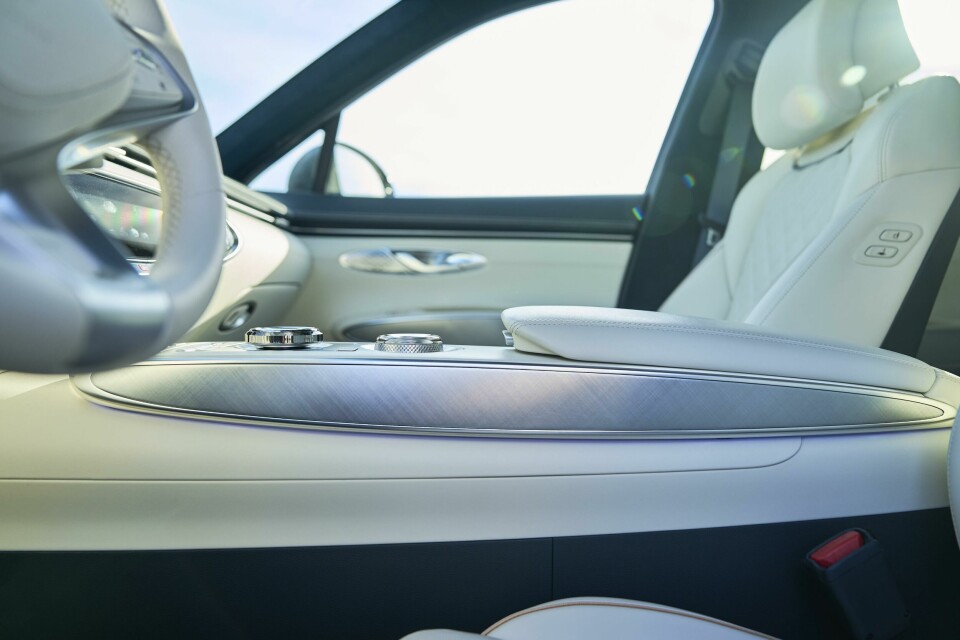
Genesis CMF designer Hailee Hyeyeon Kim juggles tradition with innovation
Hailee Hyeyeon Kim of Genesis describes how her experience in the consumer electronics world is helping sculpt her work for the luxury brand
The design crossover between consumer electronics and car interiors is becoming increasingly tangible with the digitalisation of the cockpit, implementation of advanced driver assistance and autonomous driving systems, as well as the emergence of new materials. What’s more, the gradual introduction of smart surfaces and AI-powered voice recognition tools are turning the car into an extension of the smartphone.
This makes for a tricky balance at a company like Genesis, where the traditional principle of luxury is a key brand identifier. But for senior CMF designer Hailee Hyeyeon Kim, bridging the gap between the two worlds offers exciting opportunities.

CDN: Looking back at your career so far and your experience at Toyota, Nissan and Samsung, do you have any stand-out highlights?
Hailee Hyeyeon Kim: During my tenure at Toyota and Nissan, some of the most memorable projects included the CMF designs for the Toyota Prius C, Nissan Roox, and the GT-R.
For the Prius C, a hybrid car in high demand across global markets, I focussed on creating a design that offered diverse options while expressing a distinct personality that complemented its innovative character. The Roox project involved crafting a design that captured Japan’s unique lifestyle and addressed the demand for compact cars, deepening my understanding of Japan’s distinctive “Kei car” segment.
Additionally, proposing the special colour “Blue Heaven” for the GT-R was a pivotal moment for me. This endeavor allowed me to merge historical significance with contemporary sensibilities, an exhilarating process of balancing heritage with modernity.
Tradition provides the foundation for great design, but the future demands innovation and modernity
At Samsung, I contributed to the CMF design of bespoke air purifiers and air conditioners, an experience that opened my eyes to the unique challenges of appliance design compared to automotive design. In the realm of consumer electronics, the design must not only showcase cutting-edge technology but also harmonise seamlessly with home interiors.
This experience enriched my perspective on integrating technology and emotion, a philosophy that continues to shape my work at Genesis today.
CDN: What was the transition like from working in CMF at Toyota and Nissan to designing for Samsung? And what about the transition from Samsung to Genesis?
HHK: The transition to Samsung presented significant challenges, but it was an incredibly rewarding experience. I foresaw a future where cars would be classified as large-scale appliances, which ignited my curiosity to explore the field of electronics design. At Samsung, I worked in a fast-paced, technology-driven environment, focusing on CMF design. My primary emphasis was not only on tactile experiences but also on how emerging materials interact with digital interfaces to enhance user experience.
My goal is to create designs where tradition and innovation are seamlessly integrated, flowing naturally together
Ultimately, my passion for automotive design led me back to the industry, where I now bring a fresh perspective that integrates cutting-edge technology with modern design principles. At Genesis, I prioritise emotional and refined design, while continually striving to achieve a harmonious balance between tradition and innovation.
CDN: How does Genesis leverage traditional Korean design principles in CMF?
HHK: Genesis is rooted in Korean design and effectively expresses this through CMF. Drawing inspiration from the meticulous craftsmanship, natural textures, balance, and subtle elegance of traditional Korean arts, we reinterpret these elements in a modern context. For example, we use luxurious materials such as wood, leather, and mother-of-pearl to convey emotional elegance, while translating the essence of Korea’s traditional craftsmanship into a contemporary design language.
CDN: How do you juggle the balance between drawing on inspiration from tradition and pushing the brand into the future?
HHK: Achieving this balance is both crucial and challenging. Tradition provides the foundation for great design, but the future demands innovation and modernity. I strive to create designs that honor tradition while embracing a contemporary sensibility. For example, I reinterpret traditional textures in modern forms or experiment with new materials to create innovative designs that are rare in the automotive industry. My goal is to create designs where tradition and innovation are seamlessly integrated, flowing naturally together.
CDN: What is exciting about working in CMF at the moment? Are there any particularly interesting trends that are having a big impact on your work?
HHK: One of the most exciting aspects of the CMF field today is the development of smart materials. Materials that respond to external stimuli by changing color, texture, or function open up new possibilities for interaction. Biodegradable and recyclable materials are gaining attention, and these materials are evolving in ways that maintain vehicle durability while minimising environmental impact. Additionally, there is a growing trend that emphasises tactile experiences, with materials increasingly highlighted.
CDN: What does sustainability mean to Genesis when it comes to CMF?
HHK: Sustainability at Genesis is not just a trend, but a core value. We actively use environmentally friendly materials and sustainable technologies, designing with the goal of minimising environmental impact. For example, we are exploring ways to incorporate recyclable and bio-based materials, while also focusing on selecting durable materials that extend the vehicle’s lifespan over the long term.
Voice recognition or gesture control can replace physical buttons and switches, allowing for a cleaner, more minimalistic modern design
CDN: How is the evolution of the digital cockpit impacting CMF?
HHK: The digital cockpit is fundamentally changing the role of CMF in automotive design. As screens, touch panels, and haptic feedback become key elements of the user experience, there is a growing need for materials that complement these digital interfaces. For example, materials that enhance the readability of digital screens and reduce glare, or textures that optimise touch response, are becoming increasingly important. Additionally, new finishing techniques and materials are being combined to complement the digital experience.
CDN: What are your thoughts regarding smart surfaces, and will the development of new materials enable more of them in the vehicle?
HHK: Smart surfaces are a very exciting development. Surfaces that respond to touch, temperature, and external stimuli to change functionality make the interaction between the car and the user more intuitive and immersive. New materials that can support smart surfaces are rapidly advancing, and this will bring significant changes to vehicle design. Voice recognition or gesture control can replace physical buttons and switches, allowing for a cleaner, more minimalistic modern design. Additionally, in the future, materials that can provide both smart interfaces and emotional experiences will become even more important.
CDN: How important is CMF when it comes to creating an emotional connection between vehicle and user? Perhaps there is even a way to use CMF to give a car brand an identity?
HK: CMF plays a crucial role in creating an emotional connection between the vehicle and the user. The materials and colors used in design go beyond visual elements and directly influence the user’s emotions. For example, when entering a car, the texture of the materials or the feeling of the colors plays an important role in forming the relationship with the vehicle. Many brands are building their identity through CMF, designing each model to convey a unique and distinct emotional experience.


















